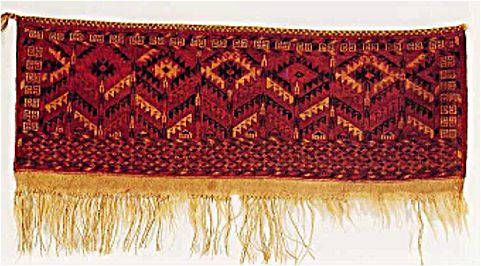
The Salon du Tapis d'Orient is a moderated discussion group in the manner of the 19th century salon devoted to oriental rugs and textiles and all aspects of their appreciation. Please include your full name and e-mail address in your posting.
by Steve Price
One commonly used criterion used for deciding whether red dyes are natural or synthetic is whether they have "run" into the white or ivory areas. Synthetic reds (even modern dyes) almost always run during washing, natural reds are said by those experienced in their use to be essentially free of this problem.
Notwithstanding this fact, it's a matter of observation that many Turkmen pieces attributed to periods well before the introduction of synthetic dyes (the first was invented in 1858, and it is unlikely that they reached the Turkmen in significant quantities until after 1875 or so) show red streaks and blotches in the white and ivory areas. These are readily apparent in almost any published source containing large numbers of Turkment rugs; by my unscientific estimate, what I will refer to as "stray reds" occur in about 10% of them. They are easily seen in the actual pieces as well, of course. That is, this is not simply a photographic artifact.
To illustrate the phenomenon, I've selected three pieces from Robert Pinner's The Rickmers Collection. I used this source because Pinner's date attributions are generally respected and unlikely to be fanciful, and the photographic reproduction in the book is excellent. The three I show here are not the only examples in the book, but they do show the stray reds rather clearly and they come from three different tribes, showing that this is not something peculiar to only one Turkmen subgroup.

This is Plate 1, two fragments of a Saryk main carpet attributed to the early 19th century or before.

This is Plate 17, a mid-19th century Tekke germetch.

Finally, Plate 48, a mid-19th century Yomud asmalyk.
The stray reds in the white or ivory areas are obvious in all three.
What is their origin? Since all three pieces predate the use of synthetic dyes by the Turkmen, they cannot be color runs if natural reds don't run. They have some other characteristics that also suggest an origin other than color runs during washing. For example, such runs generally show the most intense redness within the whites or ivories that are adjacent to red areas. This is because color runs most often seem to involve a kind of wicking action between red yarn and adjacent undyed yarn. Such a distribution of "stray red" is not the rule in old Turkmen rugs. Indeed, in the three pieces shown here there doesn't seem to be any relation between the stray red and the adjacent color.
If the stray reds didn't get there from runs during washing, and seem unrelated to adjacent colors, it seems reasonable to suppose that they were on the white or ivory wool before it was put onto the loom. If that is the case, they might be expected to occur in horizontal bands, as a sort of abrash. This appears to be how they are distributed in the Yomud asmalyk. It is less obvious, but possible, that this is true in the Saryk main carpet as well. It is impossible to tell whether this is the case in the Tekke germetch.
But if they didn't get there after the weaving was complete, they must have been on the wool before it was woven. How did the stray reds get into white wool? One possibility is that the white wool was washed in water contaminated with red dye, perhaps in a vat in which other wool had been dyed red. Another is that the reddish tinge is a natural color occurring in some of the white or ivory wool in some sheep.
I don't believe I've noticed this phenomenon outside the Turkmen group, which is kind of interesting in itself.
I pose the following questions to our readers, for openers:
1. Can you offer some sensible explanations for the origin of the stray reds in Turkmen weavings, preferably (but not necessarily) with some kind of supporting evidence?
2. Do you know of any examples outside the Turkmen group in which this phenomenon can be observed?